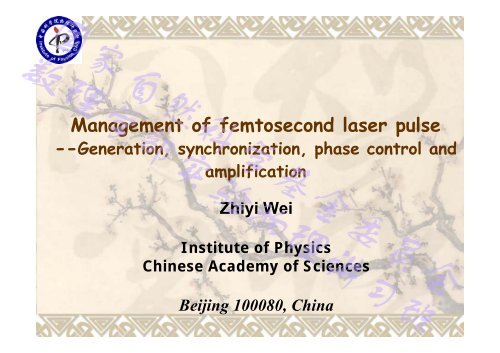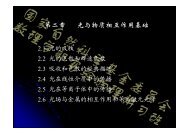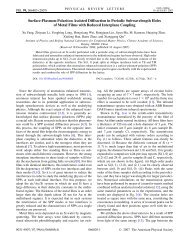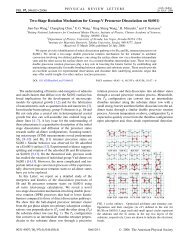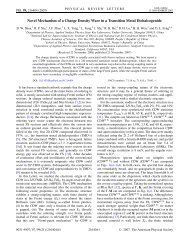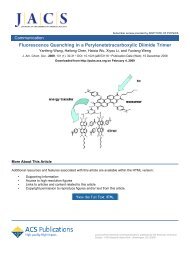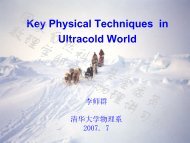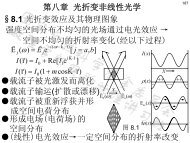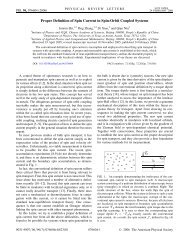飞秒激光产生与控制
飞秒激光产生与控制
飞秒激光产生与控制
You also want an ePaper? Increase the reach of your titles
YUMPU automatically turns print PDFs into web optimized ePapers that Google loves.
国家自然科学基金委员会<br />
数理学部实验物理讲习班<br />
Management of femtosecond laser pulse<br />
--Generation, synchronization, phase control and<br />
amplification<br />
Zhiyi Wei<br />
Institute of Physics<br />
Chinese Academy of Sciences<br />
Beijing 100080, China
国家自然科学基金委员会<br />
数理学部实验物理讲习班<br />
Outline<br />
Femtosecond generation<br />
Synchronization<br />
Carrier-envelope phase control<br />
Amplification<br />
Route toward attosecond world<br />
Summary<br />
2
国家自然科学基金委员会<br />
数理学部实验物理讲习班<br />
Outline<br />
Femtosecond generation<br />
Synchronization<br />
Carrier-envelope phase control<br />
Amplification<br />
Route toward attosecond world<br />
Summary<br />
3
国家自然科学基金委员会<br />
数理学部实验物理讲习班<br />
A history of pursue time limit<br />
Toward Monocycles pulse (
国家自然科学基金委员会<br />
数理学部实验物理讲习班<br />
Mechanism:<br />
Type:<br />
Starting:<br />
Activity:<br />
Parameters<br />
How to get very short pulse<br />
--- Advanced mode locking techniques<br />
Kerr Lens Mode<br />
Locking<br />
Passive<br />
Non self starting<br />
Push or tap<br />
mirror<br />
< 10 fs, >100 nm<br />
Active mode<br />
locking by AOM<br />
Active<br />
Modulator<br />
Modulator<br />
always on<br />
< 100 fs<br />
Saturable bragg<br />
reflectors (SBR)<br />
Passive<br />
Self starting<br />
SBR as cavity<br />
mirror<br />
< 20 fs, > 40 nm<br />
Large bandwidth: with Fourier Transform limit: Δν Δτ < 0.314<br />
laser medium should has a wider gain band. Dye, Ti:sapphire.<br />
Dispersion compensation: consider high order dispersion.<br />
the large bandwidth, the difficult for compensation<br />
5
国家自然科学基金委员会<br />
数理学部实验物理讲习班<br />
Kerr Lens Mode-locking laser<br />
D. E. Spence, P. N. Kean, W. Sibbett, Opt. Lett. 16, 42, 1991<br />
6
国家自然科学基金委员会<br />
数理学部实验物理讲习班<br />
Dispersion control in Ti:sapphire laser<br />
8.5fs<br />
Jianping Zhou et al, Opt Lett, Vol. 19, 1149( 1194)<br />
Lin Xu et al, Opt Lett, Vol. 21, 1259(1996)<br />
controlled by prism pair controlled by chirped mirrors<br />
Thin crystal and accurate dispersion compensation result the very short pulse.<br />
7
国家自然科学基金委员会<br />
数理学部实验物理讲习班<br />
What is chirped mirror<br />
the perfect source for negative GDD<br />
8
国家自然科学基金委员会<br />
数理学部实验物理讲习班<br />
Prism controlled Ti:sapphire laser<br />
600mm<br />
Size:600mm×200mm×150mm<br />
200mm<br />
Stability 1W<br />
Pulse duration 15~30fs<br />
Peak Power ~1MW<br />
Tunable range 760nm~850nm<br />
Repetition rate 50~100MHz<br />
9
国家自然科学基金委员会<br />
数理学部实验物理讲习班<br />
Intensity<br />
8<br />
7<br />
6<br />
5<br />
4<br />
3<br />
2<br />
1<br />
Pulse duration and stability<br />
Ultralasers<br />
0<br />
-40 -20 0 20 40<br />
Time delay (fs)<br />
国家自然科学基金委员会<br />
数理学部实验物理讲习班<br />
Chirped mirror Ti:sapphire laser<br />
M3<br />
5W 532nm Millennia<br />
f=10 cm M1 M2<br />
Ti:sa<br />
OC T=10%<br />
M1-M3: Chirped mirrors, F≈ 160 MHz<br />
11
国家自然科学基金委员会<br />
数理学部实验物理讲习班<br />
Dispersion of Ti:S crystal and chirped mirror<br />
Dispersion of Ti:sapphire (1mm)<br />
100<br />
75<br />
50<br />
25<br />
0<br />
-25<br />
-50<br />
GDD, fs 2<br />
TOD, fs 3<br />
-75<br />
0.6 0.7 0.8 0.9 1.0<br />
wavelength /μm<br />
FOD, fs 4<br />
Dispersion /fs 2<br />
-100<br />
-150<br />
-200<br />
650 700 750 800 850 900 950 10001050<br />
Ti:sapphire crystal Chirped mirror<br />
100<br />
50<br />
0<br />
-50<br />
wavelength /nm<br />
12
国家自然科学基金委员会<br />
数理学部实验物理讲习班<br />
Refractive index and dispersion of air<br />
Refractive index of air<br />
1.000279<br />
1.000278<br />
1.000277<br />
1.000276<br />
1.000275<br />
0.5 0.6 0.7 0.8 0.9 1.0<br />
wavelength /μm<br />
Dispersion of air<br />
30<br />
25<br />
20<br />
15<br />
10<br />
5<br />
Dispersion of 1m air<br />
0<br />
0.6 0.7 0.8 0.9 1.0<br />
wavelength /μm<br />
The dispersion of air is 21.3 fs2 per 1meter at wavelength of<br />
800nm, it enables us to accurately adjust dispersion by air<br />
GDD, fs 2<br />
TOD, fs 3<br />
FOD, fs 4<br />
13
国家自然科学基金委员会<br />
数理学部实验物理讲习班<br />
Spot size /μm<br />
M3<br />
600<br />
500<br />
400<br />
300<br />
200<br />
100<br />
Spectra with SPM effect<br />
F M1 X M2<br />
0<br />
0 100 200 300 400 500 600 700 800<br />
Z /mm<br />
f = Infty<br />
f = 30cm<br />
f = 20cm<br />
OC<br />
Intensity<br />
1.0<br />
0.8<br />
0.6<br />
0.4<br />
0.2<br />
532 nm<br />
x=0.3 mm<br />
x=0.2<br />
x=0.1<br />
1064 nm<br />
0.0<br />
500 600 700 800 900 1000 1100<br />
wavelength /nm<br />
We calculate the waist size inside<br />
the Ti:Sa crystal is 10.9 μm, Moving<br />
M2 will lead to the change of SPM<br />
14
国家自然科学基金委员会<br />
数理学部实验物理讲习班<br />
Optimized ultrabroaden spectrum<br />
Spectral intensity<br />
1.0<br />
0.8<br />
0.6<br />
0.4<br />
0.2<br />
532 nm<br />
0.0<br />
500 600 700 800 900 1000 1100<br />
wavelength /nm<br />
1064 nm<br />
Directly output from the oscillator, covered from 550~1050nm<br />
We generated the quasi-octave spanning spectrum with the<br />
simplest laser configuration<br />
15
国家自然科学基金委员会<br />
数理学部实验物理讲习班<br />
Measurement of laser pulse<br />
Sub-10fs oscillator<br />
autocorrelator<br />
Wedges<br />
Chirped<br />
mirror<br />
Ag mirror<br />
Ag mirror<br />
Chirped<br />
mirror<br />
Layout Interferometer autocorrelator<br />
16
国家自然科学基金委员会<br />
数理学部实验物理讲习班<br />
Intensity (arb.units)<br />
8<br />
6<br />
4<br />
2<br />
Pulse duration and spectrum<br />
7fs<br />
0<br />
-30 -20 -10 0 10 20 30<br />
Time(fs)<br />
Intensity(a.u)<br />
600 700 800 900 1000<br />
One of the shortest pulse generated with the simplest laser<br />
configuration in the world. 7fs/300mW/160MHz<br />
1.0<br />
0.8<br />
0.6<br />
0.4<br />
0.2<br />
0.0<br />
Wavelength(nm)<br />
17
国家自然科学基金委员会<br />
数理学部实验物理讲习班<br />
Compare to the similar<br />
experiment<br />
18
国家自然科学基金委员会<br />
数理学部实验物理讲习班<br />
Generation fs pulse with other media<br />
Cr:forsterite, Cr:YAG, Yb:YAG….<br />
Ti:Sapphire Cr:Forsterite Cr:YAG<br />
800 nm 1300 nm<br />
1500 nm<br />
Emission spectra of typical tunable laser crystals<br />
Some progresses:<br />
Nd:glass and Yb:glass, produce 60 fs Opt Lett.22, 307,1997<br />
Yb:glass produce 60 fs Optics Lett. 23, 126, 1998<br />
Cr:LiSAF produce 45 fs Optics Lett. 22, 621, 1997<br />
19
国家自然科学基金委员会<br />
数理学部实验物理讲习班<br />
Experiment of fs Cr:forsterite laser<br />
M1~M3:100mm ROC Reflector<br />
M4&M5: Chirped mirrors.<br />
Cr:forsterite:Gain medium in 10mm length<br />
Larger interval<br />
1030 1064<br />
Lasing region<br />
1100 1400<br />
照片<br />
20
国家自然科学基金委员会<br />
数理学部实验物理讲习班<br />
Specifications<br />
Pulse duration: 29fs<br />
Output power: 105mW<br />
Central wavelength: 1285nm<br />
Bandwidth: 60nm<br />
Repetition rate: 82.6MHz<br />
Stability:
国家自然科学基金委员会<br />
数理学部实验物理讲习班<br />
Advantage and disadvantage of Ti:S laser<br />
Short pulse: ≈ 5 fs,<br />
High gain<br />
Low energy and average power: ~10nJ, 500mW<br />
Indirectly pump: Large size and low efficiency<br />
Today, diode pump femtosecond laser show a new direction in future.<br />
Yb:YAG thin-disk laser: 60 W average output power<br />
Picosecond regime: 6-24 ps, 34 MHz, 1.8 µJ, < 280 kW<br />
Femtosecond regime: 720 fs, 34 MHz, 1.7 µJ, 2.1 MW<br />
Yb:KYW thin disk laser: 22 W average output power<br />
240 fs, 25 MHz, 0.9 µJ, 3.3 MW, focusable intensity:2 x 1014 W/cm2 Yb:YAG thin disk laser + pulse compression:<br />
24 fs, 0.56 µJ, 57 MHz, Opt. Lett. 28, 1951, 2003<br />
22
国家自然科学基金委员会<br />
数理学部实验物理讲习班<br />
Next generations of femtosecond lasers<br />
Diode directly pumped fs solid-state laser<br />
High average power: up to 100W<br />
High efficiency: up to 40%<br />
Compact size<br />
Longer pulse: ~100fs<br />
Femtosecond fiber laser<br />
Average power: up to 200mW<br />
Ultra-compact size.<br />
Long pulse: 100fs~200fs<br />
Er: fiber laser: 1570nm/200fs/150mW<br />
SHG: 785nm/100fs/20mW<br />
An ideal seeding for Ti:S laser amplifier with 100fs pulse<br />
Yb:fiber: 1030nm/200fs/200mW<br />
Directly amplification by diode laser pump<br />
23
国家自然科学基金委员会<br />
数理学部实验物理讲习班<br />
Outline<br />
Femtosecond generation<br />
Synchronization<br />
Carrier-envelope phase control<br />
Amplification<br />
Route toward attosecond world<br />
Summary<br />
24
国家自然科学基金委员会<br />
数理学部实验物理讲习班<br />
Motivation of synchronizing fs laser<br />
In many applications, femtosecond laser with single<br />
wavelength is not enough. For the researches on pumpprobe<br />
spectroscopy, generation of difference frequency,<br />
fast ignition laser fusion etc, synchronization between<br />
different lasers is necessary.<br />
λ2<br />
Probe laser<br />
λ1<br />
Detector<br />
Pump laser<br />
A.Leitensdorfer et al; Opt Lett, Vol. 20, 916(1995)<br />
25
国家自然科学基金委员会<br />
数理学部实验物理讲习班<br />
PZT<br />
Passively synchronize two fs laser<br />
HR<br />
P2<br />
PZT Driver<br />
F2<br />
S-P T-40Z-106C<br />
P1<br />
Cr:F<br />
M5<br />
M7 SESAM<br />
M4<br />
M2<br />
M6<br />
Ti:S<br />
M1<br />
S-P Millennia Xs<br />
P3<br />
M3F1<br />
Opt Lett, Lett,<br />
Vol.26,1806 (2001),<br />
Appl Phys B, Vol74.S171, (2002)<br />
P4<br />
T1<br />
T2<br />
RG<br />
PD<br />
To AC<br />
and CC<br />
For the first we realized the<br />
synchronized femtosecond laser<br />
with different gain media, the<br />
timing jitter is less than 1fs<br />
PD<br />
f rep (75,761***Hz)<br />
300<br />
250<br />
200<br />
150<br />
Ti:sapphire laser<br />
600mW/18fs/820nm<br />
Cr:forsterite laser<br />
200mW/42fs/1300nm<br />
0 1 2 3 4 5 6 7<br />
350<br />
26
国家自然科学基金委员会<br />
数理学部实验物理讲习班<br />
Stable synchronized fs Ti:sapphire laser<br />
Average power: >1W<br />
Pulse duration: 30~70fs<br />
Tunable range: 740~850nm<br />
Timing jitter: 10μm<br />
Opt Lett, Vol.26,1806 (2001), Opt Lett,Vol.30, 2121 (2005),<br />
27
国家自然科学基金委员会<br />
数理学部实验物理讲习班<br />
1250nm/65fs<br />
Cr:forsterite laser<br />
820nm/54fs<br />
B.S<br />
Ti:sapphire laser<br />
Measurement of timing jitter<br />
PZT<br />
Driver<br />
PZT<br />
BBO<br />
Oscilloscope<br />
Grating<br />
PMT<br />
The layout of the configuration for measurement of the cross correlation<br />
traces. B.S: Metal beam splitter. The signals of cross-correlation and two<br />
autocorrelations were dispersed with the grating for easy observation.<br />
28
国家自然科学基金委员会<br />
数理学部实验物理讲习班<br />
Timing jitter of synchronized Ti:S and Cr:F laser<br />
Normalized Intensity<br />
1.0<br />
0.8<br />
0.6<br />
0.4<br />
0.2<br />
FWHM:<br />
74± 2fs<br />
0.0<br />
-150 -100 -50 0 50 100 150<br />
0<br />
0 1 2 3 4 5<br />
Time Delay (fs)<br />
Time(s)<br />
The SFG of Ti:sapphire and Cr:forsterite lasers. FWHM corresponding to<br />
the SFG cross correlation trace is 74± 2fs.<br />
Intensity of SFG(a.u)<br />
50<br />
40<br />
30<br />
20<br />
10<br />
V=41.424( average)<br />
ΔV = 0.494438 (standard deviation )<br />
ΔΚ ⇔ Δ V/V<br />
Intensity fluctuation at half maximum of cross correlated trace between two<br />
lasers can be taken as linearly proportional to the timing jitter. We deduced<br />
the timing jitter is 0.7fs at 1kHz bandwidth over 5s.<br />
29
国家自然科学基金委员会<br />
数理学部实验物理讲习班<br />
Timing jitter of synchronized Ti:Sa lasers<br />
Cross-correlation trace (left) and the intensity fluctuation at half amplitude (right)<br />
The measured cross-correlation trace shows a typical FWHM of about 60 fs,<br />
We deduced the timing jitter is 0.4fs at 1kHz bandwidth over 5s.<br />
Jinrong.Tian, Zhiyi Wei et al, OL, Aug 15. (2005).<br />
30
国家自然科学基金委员会<br />
数理学部实验物理讲习班<br />
Active Synchronized two different lasers<br />
1064nm ML Nd:YVO4<br />
Laser, 1W/7ps<br />
ML Ti:S Laser,<br />
700mW/50fs<br />
Cavity length<br />
Control<br />
816MHz<br />
PLL<br />
68MHz<br />
PLL<br />
Spectrometer<br />
Poster<br />
BBO<br />
length<br />
adjustment<br />
Sum frequency<br />
laser<br />
Oscilloscope<br />
ps laser:1064nm/488ps/10W, fs laser: 800nm/50fs/600mW<br />
31
国家自然科学基金委员会<br />
数理学部实验物理讲习班<br />
Sum frequency generation<br />
spots distribution<br />
through a triple<br />
prism<br />
The 1064nm technique 810nmopen 532nm a new way 460nm to generate stable 405nm<br />
femtosecond laser pulse at new wavelength.<br />
32
国家自然科学基金委员会<br />
数理学部实验物理讲习班<br />
Outline<br />
Femtosecond generation<br />
Synchronization<br />
Carrier-envelope phase control<br />
Amplification<br />
Route toward attosecond world<br />
Summary<br />
33
国家自然科学基金委员会<br />
数理学部实验物理讲习班<br />
Carrier-envelope phase of fs laser<br />
Control the carrier envelope phase<br />
offset (CEO) is a very important<br />
topics in ultrafast science and<br />
frequency metrology.<br />
E(ω,t) =E0(t)exp(iω t+φ)<br />
CEO lead to the comb shift<br />
Δφ =2πδ /F<br />
F<br />
Repetition rate<br />
f=c /2nl<br />
Longitudinal mode frequency<br />
fn=δ + nF<br />
f 2n –2f n = δ + 2nF - 2( δ + nF )=-δ<br />
⎯D.J.Jones et al., Science 288, 635(2000)<br />
F<br />
F<br />
δ<br />
Δφ<br />
f n =nF+δ f 2n =2nF+δ<br />
f<br />
34
国家自然科学基金委员会<br />
数理学部实验物理讲习班<br />
λ/2<br />
f =nF + δ<br />
Self-reference technique<br />
Fiber<br />
λ/2<br />
Home-made fs<br />
Ti:sapphire laser<br />
λ/2<br />
APD<br />
KTP APD<br />
Grating<br />
Stabilizing laser cavity length for locking frep Modulating pump power for locking δ<br />
35
国家自然科学基金委员会<br />
数理学部实验物理讲习班<br />
Layout of experiment for CEP control<br />
PLL<br />
for CEP<br />
Grating<br />
PLL<br />
for frep TV-Rb clcok<br />
10MHz<br />
PCF<br />
antenna<br />
36
国家自然科学基金委员会<br />
数理学部实验物理讲习班<br />
Intensity / a.u.<br />
1<br />
0.1<br />
0.01<br />
White continuum with<br />
photonic crystal fiber<br />
200 400 600 800 1000 1200<br />
Wavelength / nm<br />
Intensity(arb.units)<br />
10 3<br />
10 2<br />
10 1<br />
400 500 600 700 800 900 1000 1100<br />
Wavelength(nm)<br />
37
国家自然科学基金委员会<br />
数理学部实验物理讲习班<br />
Locking of repetition rate<br />
Without Locking<br />
Locking<br />
38
国家自然科学基金委员会<br />
数理学部实验物理讲习班<br />
Comparison<br />
Before locking:~10 -7 After locking:~10 -12<br />
The uncertain of repetition rate: ΔF=10MHz×10-12 ~10mHz<br />
We need more high precision clock<br />
39
国家自然科学基金委员会<br />
数理学部实验物理讲习班<br />
Increasing of beat frequency signal<br />
S/N dB<br />
-10<br />
-20<br />
-30<br />
-40<br />
-50<br />
-60<br />
-70<br />
-80<br />
0.0 20.0 40.0 60.0 80.0 100.0 120.0<br />
Frequency(MHz)<br />
About 50 dB<br />
40
国家自然科学基金委员会<br />
数理学部实验物理讲习班<br />
Locking of CE phase with TV-Rb clock<br />
RF frequency(MHz)<br />
90<br />
80<br />
70<br />
60<br />
50<br />
40<br />
30<br />
20<br />
10<br />
f rep<br />
Without Locking<br />
f ceo<br />
RF frequency(MHz)<br />
20<br />
18<br />
16<br />
14<br />
12<br />
10<br />
8<br />
6<br />
Without locking<br />
Locking<br />
0 50 100 150 200 250 300 350<br />
Time(s)<br />
Locking<br />
0<br />
0 50 100 150 200 250 300 350<br />
Time(s)<br />
41
国家自然科学基金委员会<br />
数理学部实验物理讲习班<br />
Performance of beat frequency with PCF<br />
Ultrabroaden spectrum, cover from blue to<br />
infrared range.<br />
No special need for laser power and pulse<br />
duration.<br />
Very sensitive for beam point direction, any slight<br />
shift will lead to the CEP control unstable.<br />
The surface of fiber easily to be damaged, can<br />
not running for long time.<br />
Larger transmission loss lead to the lower output<br />
power.<br />
A complicate electronics is necessary to control<br />
the repetition rate and CEP frequency<br />
42
国家自然科学基金委员会<br />
数理学部实验物理讲习班<br />
DFG: Difference frequency generation:<br />
fDFG = f1 -f2 = (δ+mfrep )-(δ+nfrep )= (m-n)frep f − f DFG = [( m − n)<br />
f rep + δ ) − ( m − n)<br />
f rep = δ<br />
I (f)<br />
Optical frequency comb with DFG<br />
f 2 =δ+nf rep<br />
δ<br />
f 1 =δ+mf rep<br />
fDFG = (m-n)frep frep frep Beat signal<br />
DFG of the ultra-broaden band<br />
laser spectrum will generate a<br />
self-stabilized femtosecond<br />
frequency comb at wavelength<br />
around 1.5micrometer.<br />
f<br />
DFG: 627-1000nm⇒1680nm(ω)<br />
Free CE phase, f1 = nfrep SHG: 1680nm ⇒840nm(2ω)<br />
Free CE phase, f2 = 2nfrep M. Zimmermann et al., MPQ; T. Fuji et al., TUW; S. M. Foreman et al., JILA&MIT<br />
43
国家自然科学基金委员会<br />
数理学部实验物理讲习班<br />
Experimental layout for dispersion adjust<br />
M3<br />
W<br />
Auto-Correlator<br />
F M1 X M2<br />
M4<br />
M5<br />
W<br />
OC<br />
Ag<br />
Dispersion<br />
compensation<br />
M1~M5:Chirped Mirrors; W: wedges; OC: 10% Output coupler<br />
X: 2mm Ti:sapphire crystal; F: 50mm focus lens.<br />
44
国家自然科学基金委员会<br />
数理学部实验物理讲习班<br />
Pump laser<br />
Experimental of DFG<br />
AOM<br />
7fs Ti:s Oscillator<br />
CM<br />
PD<br />
W<br />
PP-MgO:LN<br />
CM: Chirped Mirrors, W:Wedges, LF: Long pass filter,<br />
PD: Photo diode for infrared, AOM: AO modulator<br />
LF<br />
Ag Mirror<br />
Ag Mirror<br />
45
国家自然科学基金委员会<br />
数理学部实验物理讲习班<br />
Intensity(arb.unit)<br />
1<br />
0.1<br />
0.01<br />
1E-3<br />
Beat frequency spectrum<br />
1100 1200 1300 1400 1500 1600 1700<br />
Wavelength(nm)<br />
Spectrum of DF laser<br />
Power spectrum(dBm)<br />
-20<br />
-30<br />
-40<br />
-50<br />
-60<br />
-70<br />
-80<br />
0 40 80 120 160 200<br />
Frequency(MHz)<br />
Beat frequency (fceo: 30dB)<br />
46
国家自然科学基金委员会<br />
数理学部实验物理讲习班<br />
Control Cs clock with<br />
GPS receiver<br />
GPS receiver<br />
Cs clock<br />
10MHz<br />
Function<br />
generator~<br />
20GHz<br />
10MHz<br />
Control F<br />
Control fceo<br />
47
国家自然科学基金委员会<br />
数理学部实验物理讲习班<br />
Electronics system for frequency locking<br />
Cs clock<br />
Function<br />
generator<br />
Fs laser<br />
To PZT<br />
8GHz<br />
electrical<br />
pulse<br />
160MHz<br />
signal<br />
8GHz<br />
Band filter<br />
8GHz<br />
Band filter<br />
GPS receiver<br />
Low pass<br />
amplifier<br />
Low pass<br />
filter<br />
Low pass<br />
filter<br />
comparator<br />
48
国家自然科学基金委员会<br />
数理学部实验物理讲习班<br />
Stability of Cs clock<br />
49
国家自然科学基金委员会<br />
数理学部实验物理讲习班<br />
Locking repetition rate with high accuracy<br />
Locking the 50th<br />
harmonic of repetition<br />
rate 8GHz with the<br />
function generator, It<br />
leads to an accuracy<br />
of μHz<br />
Frequency(uHz)<br />
40<br />
20<br />
0<br />
-20<br />
-40<br />
0 200 400 600 800<br />
Time(s)<br />
We design and made the PLL electronics to control cavity length by PZT<br />
50
国家自然科学基金委员会<br />
数理学部实验物理讲习班<br />
CEO Frequency(MHz)<br />
20.4<br />
20.2<br />
20.0<br />
19.8<br />
19.6<br />
Locking CEP by control the AOM<br />
Before locking:<br />
The fluctuation of fceo<br />
within 5min is about 3MHz<br />
0 200 400 600 800 1000<br />
Time(s)<br />
After locking:<br />
The fluctuation of fceo<br />
within 17min is only 2Hz<br />
23000000<br />
22500000<br />
22000000<br />
21500000<br />
21000000<br />
20500000<br />
20000000<br />
19500000<br />
19000000<br />
18500000<br />
18000000<br />
00:00:00.0<br />
00:00:25.1<br />
20000021.5<br />
20000021<br />
20000020.5<br />
20000020<br />
20000019.5<br />
20000019<br />
20000018.5<br />
20000018<br />
00:00:50.3<br />
00:01:15.4<br />
00:01:40.9<br />
00:02:06.2<br />
00:02:31.5<br />
00:02:56.8<br />
00:03:22.1<br />
00:03:47.4<br />
00:04:12.6<br />
00:04:37.9<br />
00:05:03.0<br />
00:05:28.1<br />
21:59:22.0<br />
22:00:33.0<br />
22:01:43.0<br />
22:02:53.0<br />
22:04:04.0<br />
22:05:14.0<br />
22:06:25.0<br />
22:07:35.0<br />
22:08:46.0<br />
22:09:56.0<br />
22:11:07.0<br />
22:12:17.0<br />
22:13:27.0<br />
22:14:38.0<br />
22:15:48.0<br />
22:16:59.0<br />
We use the Menlo Inc electronics to control the CEP frequency by AOM<br />
系列1<br />
51<br />
系列1
国家自然科学基金委员会<br />
数理学部实验物理讲习班<br />
Fluctuations after optimized locking<br />
Frequency(mHz)<br />
180<br />
150<br />
120<br />
90<br />
60<br />
30<br />
0<br />
B<br />
-30<br />
0 100 200 300 400 500 600<br />
A<br />
Time(s)<br />
A. The fluctuation of locked repetition rate<br />
B. The fluctuation of locking fceo 52
国家自然科学基金委员会<br />
数理学部实验物理讲习班<br />
Outline<br />
Femtosecond generation<br />
Synchronization<br />
Carrier-envelope phase control<br />
Amplification<br />
Route toward attosecond world<br />
Summary<br />
53
国家自然科学基金委员会<br />
数理学部实验物理讲习班<br />
Chirped Pulse Amplification<br />
D. Strickland and G. Mourou, Optics Commun. 56, 219 (1985)<br />
54<br />
t
国家自然科学基金委员会<br />
数理学部实验物理讲习班<br />
Development of laser power<br />
P<br />
th<br />
hν<br />
= Δν<br />
g<br />
σ<br />
55
国家自然科学基金委员会<br />
数理学部实验物理讲习班<br />
TW laser facilities at IOP<br />
Extreme Light-I(1999)<br />
Pulse Energy:36mJ<br />
Duration:25fs<br />
Peak Power:>1.4TW<br />
Extreme Light-II (2001)<br />
Pulse Energy: 640mJ<br />
Duration:31fs<br />
Peak Power: ~20TW<br />
56
国家自然科学基金委员会<br />
数理学部实验物理讲习班<br />
Solid State Amplifier Desires<br />
High Efficiency in Final Amplifier<br />
Run above the saturation fluency<br />
J sat<br />
Produce the shortest duration pulses<br />
Run near the fluorescence limit<br />
No Damage<br />
Run below the dielectric breakdown limit< 5x10 9 W/cm 2<br />
57
国家自然科学基金委员会<br />
数理学部实验物理讲习班<br />
Maximum Intensity at Saturation<br />
Material<br />
Jsat<br />
(J/cm2 )<br />
Δtmin<br />
(fs)<br />
Maximum output intensity = J sat / Δt min<br />
Imax<br />
(W/cm2 )<br />
Nd:Silicate 6 60 10 14<br />
Yb:Silicate 32 20 1.6x10 15<br />
Ti:Sapphire 1 3 3.3x10 14<br />
However, damage threshold
国家自然科学基金委员会<br />
数理学部实验物理讲习班<br />
General Chirped Pulse Amplification<br />
Short pulse<br />
oscillator<br />
t<br />
Dispersive delay line<br />
Solid state amplifiers<br />
Saturation is Reached Safely<br />
Δt stretch = J sat /I damage<br />
Nd:Glass ~ 1 ns<br />
Ti:Al2O3 ~ 200 ps<br />
Peak Power Increase Proportional to<br />
Δtstretch > 1000<br />
t<br />
t<br />
Inverse delay line<br />
t 59
国家自然科学基金委员会<br />
数理学部实验物理讲习班<br />
Martinez Stretcher<br />
Classification of stretcher<br />
aberration, can not<br />
compress pulse shorter<br />
than 50fs<br />
Öffner Stretcher<br />
free aberration, most widely<br />
use<br />
Material Stretcher<br />
Use high dispersion material,<br />
suit for 10fs⇒ ~10ps<br />
Graing1<br />
Red<br />
L1(f) L2(f)<br />
Blue<br />
L 2f<br />
L<br />
SF57<br />
Graing2<br />
O<br />
60
国家自然科学基金委员会<br />
数理学部实验物理讲习班<br />
⎡ω<br />
ω ⎢ χ<br />
⎣<br />
' ' L<br />
G(<br />
) exp<br />
c<br />
= ⎜<br />
⎛<br />
⎟<br />
⎞ ω ⎝ ⎠<br />
Gain narrowing effect<br />
⎤<br />
⎥<br />
⎦
国家自然科学基金委员会<br />
数理学部实验物理讲习班<br />
Approaches to Gain Narrowing Control<br />
Minimize systems losses<br />
Multi-pass amplifiers with high gain per pass<br />
Seed to the RED of the line center<br />
Regen or multi-pass<br />
Play off saturation pulling against gain shifting<br />
Mix amplifier materials<br />
Different center frequency yields higher overall gain<br />
bandwidth<br />
Regenerative pulse shaping<br />
Correct for the gain narrowing on each pass trip<br />
OPCPA (Optical Parametric CPA)<br />
Large gain bandwidth in parametric amplification<br />
62
国家自然科学基金委员会<br />
数理学部实验物理讲习班<br />
HR<br />
Spectral Fliter<br />
c<br />
T( ω)=<br />
G( ω )<br />
Regenerative Pulse Shaping<br />
Thin Film Polarizer<br />
Amplified Pulse<br />
国家自然科学基金委员会<br />
数理学部实验物理讲习班<br />
Polarizer<br />
Pockels cell<br />
Periscope<br />
10 pass preamplifier<br />
Polarizer<br />
Berek<br />
Z.Cheng ,F.Krausz, Ch.Spielmann, Opt. Commun 201, 145 (2002)
国家自然科学基金委员会<br />
数理学部实验物理讲习班<br />
Seed<br />
pulse<br />
Optical Parametric CPA(OPCPA)<br />
Stretching,<br />
shaping,<br />
timing<br />
BBO, LBO, CLBO, RTP, KTA, KDP, DKDP,YCOB…<br />
Pump<br />
pulse<br />
OPA<br />
Compressor<br />
Laser amplifier is replaced by OPA<br />
Output<br />
pulse<br />
from 100 fs to 10 ns<br />
A.Dubietis, G.Jonušauskas, A.Piskarskas, Opt. Commun, 88, 437 (1992)<br />
65
国家自然科学基金委员会<br />
数理学部实验物理讲习班<br />
OPCPA VS. CPA BASED ON A GAIN MEDIUM<br />
OPCPA CPA based on Ti:Sa crystal<br />
Gain bandwidth >100THz ~ 30 THz<br />
Single-pass gain ~ 10 6 < 10<br />
B-integral Low < 1.0 High > 1.0<br />
Thermal load Negligible (-> high repetition rate)<br />
Non-thermal lensing effect<br />
Storage of energy Instantaneous<br />
(Strict synchronization ~ ps)<br />
Huge (-> low repetition rate)<br />
Thermal lensing effect<br />
~ µs<br />
( Relaxed synchronization ~ ns)<br />
Pedestal Amplified superfluorescence Amplified spontaneous emission<br />
Gain wavelength Variable Fixed<br />
ADVANTAGES:<br />
Extremely broad gain bandwidth<br />
High gain in single pass<br />
Low thermooptics (high output beam<br />
quality)<br />
High contrast ratio (reduced ASE)<br />
DISADVANTAGES:<br />
No pump energy accumulation (high intensity<br />
pump required)<br />
Losses introduced by idler wave<br />
Limited aperture of nonlinear crystals<br />
Precise pump/signal synch. required
国家自然科学基金委员会<br />
数理学部实验物理讲习班<br />
Shortest pulses from OPCPA by year<br />
[1] A. Dubietis et al, Opt.<br />
Commun. 88, 437 (1992)<br />
[2] V.V. Yakovlev et al,<br />
Opt. Lett. 19, 2000 (1994)<br />
[3] G. Cerullo et al, Appl.<br />
Phys. Lett. 71, 3616 (1997)<br />
[4] A. Shirakawa et al, Opt.<br />
Lett. 23, 1292 (1998)<br />
[5] A. Shirakawa et al,<br />
Appl. Phys. Lett. 74, 2268<br />
(1999)<br />
[6] A. Baltuška et al, Opt.<br />
Lett. 27, 306 (2002)<br />
OPA crystal<br />
– BBO only<br />
67
国家自然科学基金委员会<br />
数理学部实验物理讲习班<br />
General design of multi-100TW laser<br />
Oscillator<br />
20fs/5nJ/80MHz<br />
Stretcher<br />
>600ps<br />
Compressor<br />
20J/40fs/500TW<br />
Deformable mirror<br />
1.5DF/3×10 20<br />
1nJ<br />
φ2<br />
φ160<br />
200mJ/cm 2<br />
500 mJ/ 532nm/10Hz<br />
Single frequency laser<br />
500MW/cm 2<br />
OPCPA,<br />
2mJ/10 Hz<br />
φ60<br />
10 6<br />
φ14/7<br />
Power amplification<br />
>30 J/single shot<br />
J p =2J/cm 2<br />
~100J/ 532nm pump laser<br />
Single shot/about 20 min<br />
3J /532nm/1Hz<br />
J p =2J/cm 2<br />
Second stage<br />
~1J/800nm, 1Hz<br />
φ40<br />
68
国家自然科学基金委员会<br />
数理学部实验物理讲习班<br />
Arrangement for multi-100TW laser<br />
50J/527nm<br />
Pump laser<br />
50J/527nm<br />
pump laser<br />
CW 532nm<br />
pump laser<br />
fs oscillator<br />
500mW/20fs<br />
Offern<br />
Stretcher<br />
3J/532nm/1Hz<br />
Amplifier II<br />
Amplifier I<br />
500mJ/10Hz<br />
532nm SF Laser<br />
1m<br />
Final amplifier<br />
~30J/800nm/20min<br />
600mJ/30fs<br />
~20TW<br />
Compressor I Target<br />
Chamber I<br />
Area for power supply, 1X6 meters Control Platform<br />
Room size:<br />
14X8 meters<br />
Compressor II<br />
Pre-pulse<br />
Generator<br />
20J/40fs<br />
~500TW<br />
Target<br />
Chamber II<br />
Door<br />
Clear<br />
door 69
国家自然科学基金委员会<br />
数理学部实验物理讲习班<br />
Doubled trip stretcher<br />
70
71<br />
Calculation on the stretcher dispersion<br />
2<br />
2<br />
2<br />
3<br />
0<br />
0 )<br />
sin<br />
(<br />
1<br />
'<br />
2<br />
/<br />
2<br />
68<br />
.<br />
7<br />
'<br />
'<br />
)<br />
2<br />
ln<br />
4<br />
(<br />
γ<br />
λ<br />
π<br />
λ<br />
−<br />
−<br />
−<br />
•<br />
=<br />
Φ<br />
=<br />
d<br />
L<br />
R<br />
d<br />
c<br />
t<br />
t<br />
t out<br />
Phase and pulse duration<br />
after stretcher<br />
)<br />
sin(<br />
sin<br />
)<br />
sin<br />
sin<br />
(<br />
2<br />
))<br />
cos(<br />
arcsin(<br />
)<br />
sin(<br />
sin<br />
)<br />
sin<br />
sin<br />
(<br />
)<br />
sin(<br />
sin<br />
)<br />
sin<br />
sin<br />
(<br />
sin<br />
)<br />
sin(<br />
sin<br />
)<br />
sin(<br />
2<br />
sin<br />
)<br />
sin(<br />
(<br />
5<br />
0<br />
5<br />
5<br />
4<br />
5<br />
0<br />
5<br />
0<br />
5<br />
5<br />
4<br />
5<br />
0<br />
0<br />
5<br />
4<br />
51<br />
5<br />
4<br />
3<br />
2<br />
3<br />
1<br />
2<br />
1<br />
θ<br />
θ<br />
θ<br />
θ<br />
θ<br />
π<br />
θ<br />
θ<br />
λ<br />
θ<br />
θ<br />
θ<br />
θ<br />
θ<br />
θ<br />
θ<br />
θ<br />
θ<br />
θ<br />
θ<br />
θ<br />
θ<br />
θ<br />
θ<br />
θ<br />
θ<br />
θ<br />
θ<br />
ω<br />
ω<br />
+<br />
+<br />
−<br />
−<br />
+<br />
−<br />
+<br />
+<br />
−<br />
+<br />
+<br />
+<br />
−<br />
−<br />
+<br />
+<br />
−<br />
+<br />
−<br />
=<br />
Φ<br />
+<br />
=<br />
Φ<br />
R<br />
l<br />
R<br />
d<br />
d<br />
R<br />
l<br />
R<br />
R<br />
l<br />
R<br />
R<br />
R<br />
R<br />
c<br />
c<br />
P<br />
c<br />
国家自然科学基金委员会<br />
数理学部实验物理讲习班
国家自然科学基金委员会<br />
数理学部实验物理讲习班<br />
72
国家自然科学基金委员会<br />
数理学部实验物理讲习班<br />
Nd:YAG laser<br />
5ns/0.1J/532nm<br />
DG535<br />
Ti:S laser<br />
20fs/5nJ/800nm<br />
E-O Gate<br />
Stretcher: 0.6ns<br />
Design and experiment of OPCPA<br />
100mJ<br />
Telescopy×0.18<br />
Telescopy×0.01<br />
0.4J<br />
Delay Dealy<br />
Telescopy×0.3<br />
DM1 DM2 DM3 DM4<br />
LBO<br />
OPAI<br />
After OPAI<br />
~60μJ<br />
Telescope×3.8<br />
LBO<br />
OPAII<br />
compressor<br />
Problems: 1.Stable single frequency operation<br />
2.High energy necessary because of low efficiency<br />
?<br />
800nm<br />
73
国家自然科学基金委员会<br />
数理学部实验物理讲习班<br />
A new design with high efficiency<br />
Mode-Locking<br />
Nd:YVO4 laser, 100nJ<br />
500ps/1064nm/80MHz<br />
PLL Circuit for<br />
synchronized ps<br />
and fs laser<br />
Circuit for control<br />
cavity length<br />
Ti:S laser,5nJ<br />
20fs/800nm/80MHz<br />
under construction<br />
Regenerative<br />
amplifier pump<br />
with DL<br />
TV-Rb clock<br />
10MHz<br />
stretcher~ 500ps<br />
2mJ<br />
1kHz<br />
PC Dazzler<br />
Multi<br />
pass amp<br />
100mJ<br />
10Hz<br />
SHG<br />
50mJ<br />
532nm<br />
2mJ/10Hz<br />
800nm<br />
74
国家自然科学基金委员会<br />
数理学部实验物理讲习班<br />
M 1<br />
LD pumped actively mode-locking<br />
PZT<br />
The locked<br />
phase loop<br />
circuit<br />
Nd:YAG AOM OC<br />
1746mm<br />
Nd:YAG laser<br />
pin<br />
82MHz referred<br />
frequency<br />
Diagram of the all solid state<br />
active-mode locking Nd:YAG<br />
laser. The frequency is 82MHz<br />
strength coefficient<br />
1.0<br />
0.8<br />
0.6<br />
0.4<br />
0.2<br />
0.0<br />
-1000 -500 0 500 1000<br />
d l i ( )<br />
The autocorrelation trace<br />
of mode locked pulse. The<br />
full width is about 488 psec.<br />
75
国家自然科学基金委员会<br />
数理学部实验物理讲习班<br />
PC1 TFP<br />
From Stretcher<br />
λ/2<br />
MR4<br />
H<br />
MR3<br />
MR7<br />
Pump: 30mJ/532nm<br />
Output:~2mJ/800nm<br />
Regenerative amplifier<br />
To oscilloscope for monitor<br />
the amplified train trace From 1kHz pump laser<br />
PH3<br />
MP1 MR8 F3<br />
Ti:S<br />
PH4<br />
λ/4<br />
F1<br />
F2<br />
FI2<br />
MP3<br />
Glan Prism<br />
MP2<br />
MR2<br />
.H<br />
MR6<br />
PIN MR5 To Main Amp<br />
MR1<br />
76
国家自然科学基金委员会<br />
数理学部实验物理讲习班<br />
Spectrum Shaping Control with AOPDF<br />
Fa st Axis<br />
(mode 1)<br />
Acoustic<br />
wave<br />
Slow Axis (mode 2)<br />
Acoustic-Optic Programmable Dispersive Filter for spectral<br />
amplitude and phase control<br />
77
国家自然科学基金委员会<br />
数理学部实验物理讲习班<br />
Spectra with shaping technique<br />
Seeding pulse<br />
Amplified pulse without<br />
AOPDF work<br />
Amplified pulse with<br />
AOPDF work<br />
78
国家自然科学基金委员会<br />
数理学部实验物理讲习班<br />
Multi-pass amplifier<br />
From Reg.<br />
1Hz Nd:YAG<br />
2.6J@532nm<br />
Glan prism<br />
PC 3 PC 4<br />
Glan prism<br />
With 2.6J pump laser energy, amplified laser of 700mJ<br />
was obtained, corresponding to the efficiency of 27%<br />
λ/2<br />
79
国家自然科学基金委员会<br />
数理学部实验物理讲习班<br />
Layout of 100J pump laser system<br />
80
国家自然科学基金委员会<br />
数理学部实验物理讲习班<br />
81
国家自然科学基金委员会<br />
数理学部实验物理讲习班<br />
~<br />
0.2<br />
7米<br />
~<br />
0.2 0.1<br />
1<br />
米<br />
~<br />
0.3<br />
9米<br />
IR5<br />
MP1<br />
M7<br />
M4<br />
M11<br />
IR2<br />
晶体φ85×20mm<br />
MP3<br />
MP7<br />
MP2<br />
MP6<br />
M3<br />
M8<br />
M12<br />
IR4<br />
Design of final amplifier<br />
~2.16米<br />
MP4<br />
MP5<br />
PC<br />
The lower efficiency of amplification infer to the possible ASE 82<br />
IR3<br />
~2.6米<br />
~2.0米<br />
~2.16米<br />
M10<br />
<br />
Pumped the final amplifier with 80J laser at 527nm, laser<br />
energy only 5J was obtained at initial experiment.<br />
M9<br />
M2<br />
MP9<br />
M6<br />
MP10<br />
M5<br />
~ ~<br />
0.5 0.6<br />
米 米<br />
~<br />
0.7<br />
米
国家自然科学基金委员会<br />
数理学部实验物理讲习班<br />
Eliminate ASE and PL with index match material<br />
Transverse Gain<br />
10 5<br />
10 4<br />
10 3<br />
10 2<br />
10 1<br />
3<br />
4 5<br />
Beam Diameter /cm<br />
N = N = 1.76 N = N = 1<br />
1 Ti: sapphire 2 air<br />
( N − N )<br />
= = 7.6% = 1/ = 13<br />
R<br />
2<br />
1 2<br />
2<br />
( N1+ N2)<br />
G R<br />
Using thermoplastic (Cargille Laboratories, Inc.) material<br />
can well eliminate the effect.<br />
Amplified energy of 20J was obtained finally<br />
6<br />
7<br />
8<br />
83
国家自然科学基金委员会<br />
数理学部实验物理讲习班<br />
Layout of vacuum compressor<br />
Vacuum pumps<br />
Space size of the chamber:900×700mm,<br />
Incident angle: 24 degree,diffractive angle: 51degree<br />
84
国家自然科学基金委员会<br />
数理学部实验物理讲习班<br />
85
国家自然科学基金委员会<br />
数理学部实验物理讲习班<br />
Gratings of compressor<br />
86
国家自然科学基金委员会<br />
数理学部实验物理讲习班<br />
The record works on TW laser<br />
The highest peak power—850W<br />
JAERI, Japan, K.Yamakawa et al,<br />
The highest power density— 0.8X1022W/cm2 Michigan University, USA, S.Bahk et al, CLEO2004<br />
The highest peak power from OPCPA—500TW<br />
Institute of Applied Physics, Russian<br />
The highest contrast ratio— 10-11 French, USA (Michigan PW)<br />
The shortest pulse duration— 1TW/10fs,10TW/12fs<br />
AIST Japan, H.Takada et al<br />
87
国家自然科学基金委员会<br />
数理学部实验物理讲习班<br />
88
国家自然科学基金委员会<br />
数理学部实验物理讲习班<br />
Optimize CPA laser with new techniques<br />
Improved beam quality for higher focusable intensity<br />
correct wave-front distortion, adaptive optics system.<br />
Spectrum shaping for shorter pulse duration<br />
SLM (spatial liquid crystal modulator)<br />
Acoustic-optics modulator<br />
Phase controlling for stronger nonlinear interaction<br />
Carrier Envelope Phase control.<br />
Eliminate the ASE for a higher contrast ratio.<br />
Spatial filter, Pockels Cells.<br />
OPCPA-Optical Parametric Chirped Pulse Amplification<br />
DCPA,Absorber<br />
Contrast ratio: 10<br />
89<br />
-10 ~10-11 CLEO: 2005
国家自然科学基金委员会<br />
数理学部实验物理讲习班<br />
Outline<br />
Femtosecond generation<br />
Synchronization<br />
Carrier-envelope phase control<br />
Amplification<br />
Route toward attosecond world<br />
Summary<br />
90
国家自然科学基金委员会<br />
数理学部实验物理讲习班<br />
91
国家自然科学基金委员会<br />
数理学部实验物理讲习班<br />
Compression laser pulse to 5fs<br />
1kHz amplifier<br />
Femtolaser Inc<br />
25 fs<br />
1.8 mJ<br />
Ag mirror Chirped<br />
mirror<br />
Ne gas<br />
Wedge pair<br />
Chirped<br />
mirror<br />
5 - 7 fs<br />
0.9 mJ<br />
Ag mirror Ag mirror<br />
92
国家自然科学基金委员会<br />
数理学部实验物理讲习班<br />
Generation of attosecond HHG X ray laser<br />
Drescher et al. Science 291 1923 (2001)<br />
93
国家自然科学基金委员会<br />
数理学部实验物理讲习班<br />
Generation of fs sub-harmonic waves<br />
Harmonic Wave<br />
Order<br />
Waves Relation<br />
Wavelength (nm)<br />
Pulse Duration<br />
(fs)<br />
Single Max<br />
Power (mW)<br />
Multi-Waves<br />
Power (mW)<br />
Multi-Waves<br />
Power (mW)<br />
ω<br />
2580<br />
2ω<br />
Cr:Mg2 SiO4 1290<br />
20<br />
500<br />
200<br />
100<br />
3ω<br />
Ti:Al2 O3 860<br />
10<br />
1000<br />
400<br />
200<br />
4ω<br />
2ω +<br />
2ω<br />
645<br />
50<br />
200<br />
200<br />
100<br />
5ω<br />
3ω +<br />
2ω<br />
516<br />
50<br />
300<br />
300<br />
300<br />
6ω<br />
3ω<br />
+3ω<br />
430<br />
20<br />
400<br />
400<br />
200<br />
7ω<br />
3ω<br />
+4ω<br />
2ω<br />
+5ω<br />
370<br />
80<br />
100<br />
100<br />
8ω<br />
2ω<br />
+6ω<br />
3ω<br />
+5ω<br />
323<br />
80<br />
200<br />
100<br />
94
国家自然科学基金委员会<br />
数理学部实验物理讲习班<br />
Coherent synthesization for sub-fs pulse<br />
1200nm<br />
2ω<br />
800nm<br />
3ω<br />
600nm<br />
4ω<br />
480nm<br />
5ω<br />
400nm<br />
6ω<br />
Assump the duration is 5fs for each pulse,<br />
the coherent synthesization will lead to sub-1fs<br />
laser pulse.<br />
95
国家自然科学基金委员会<br />
数理学部实验物理讲习班<br />
Summary<br />
Novel technologies for femtosecond laser<br />
generation, synchronization, phase control and<br />
amplification are reviewed.<br />
We developed an oscillator with CM technique,<br />
pulse of as short as 7fs was directly generated.<br />
As our best knowledge, this is the simplest laser<br />
configuration for sub-10fs laser pulse.<br />
Passive and active synchronization with low<br />
timing jitter were developed, a feasiable new<br />
way to generate femtosecond laser pulse by sum<br />
frequency was proposed<br />
96
国家自然科学基金委员会<br />
数理学部实验物理讲习班<br />
Difference frequency the ultrabroaden<br />
spectrum with a PP-MgO:LN crystal, we obtained<br />
a beat frequency with S/N ratio of about 30dB.<br />
Locking the signal and repetition rate to a Cs<br />
clock with GPS receiver, we demonstrated a<br />
frequency comb with uncertainty of 2×10-15 Base on our previous works on TW Ti:sapphire<br />
lasers, a new facility (Extreme III) was designed.<br />
With the home-designed pump laser, the system<br />
will be capable of peak power of multi-100TW.<br />
97
国家自然科学基金委员会<br />
数理学部实验物理讲习班<br />
Acknowledgement for Collaborators<br />
Jie Zhang, Professor of IOP<br />
Staffs:<br />
Prof Yuxin Nie, Naicheng Shen,<br />
Dr Hao Teng, Mr Dehua Li, Prof Zhiguo Zhang<br />
Post-doctor,<br />
Zhaohua Wang, Qiang Du<br />
Graduated Ph D Students:<br />
Hainian Han (TsingHua Uni), Weijun Ling(Xian IOPM)<br />
Jinrong Tian(BTU, Beijing), Yulei Jia (Shang Dong Uni)<br />
Ph Students:<br />
Peng Wang, Yanying Zhao, Jiangfeng Zhu, Huan Zhao,<br />
Wei Zhang, Binbin Zhou, Xin Zhong and Changwen Xu<br />
98
国家自然科学基金委员会<br />
数理学部实验物理讲习班<br />
Thank You for your attention!<br />
99


